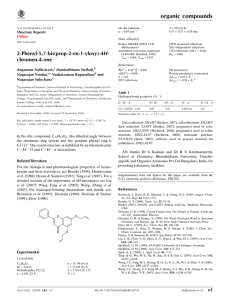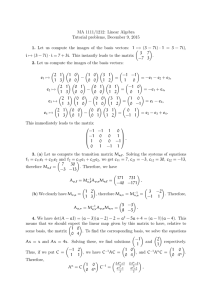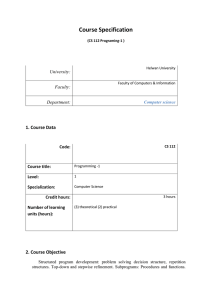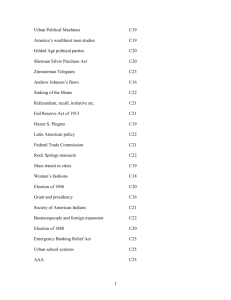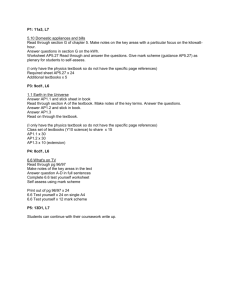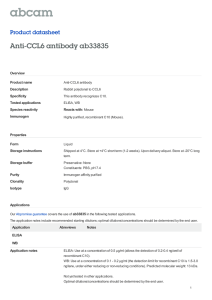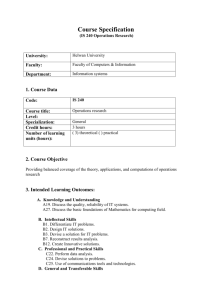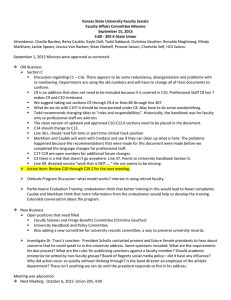Document 13501071
advertisement
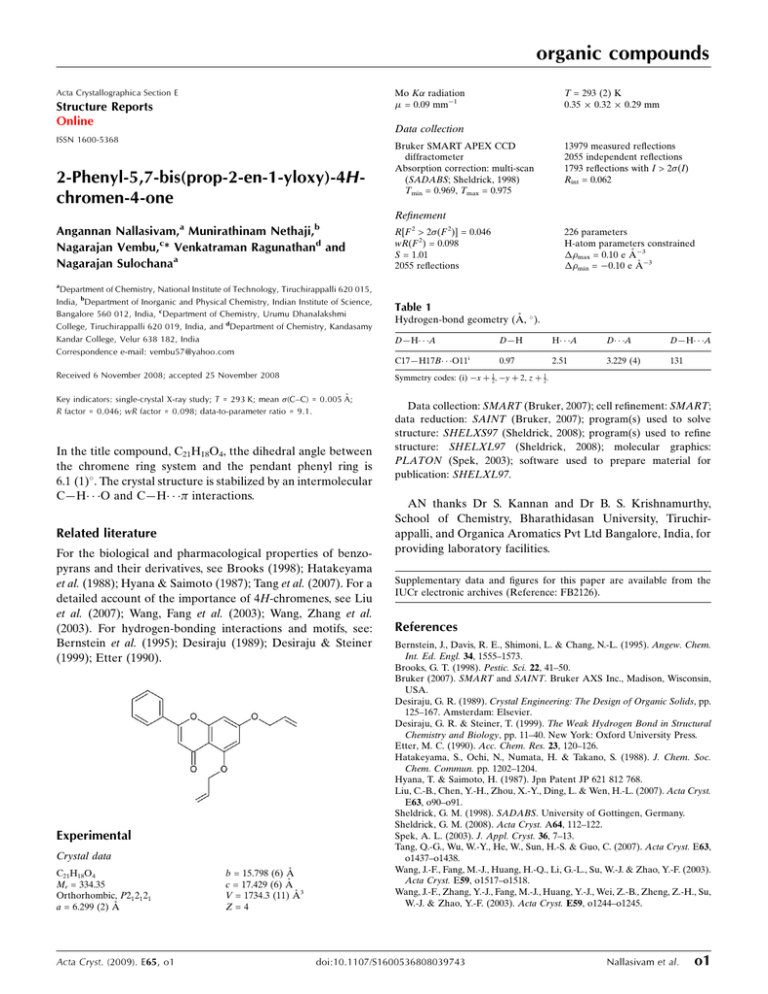
organic compounds Acta Crystallographica Section E Mo K radiation = 0.09 mm1 Structure Reports Online T = 293 (2) K 0.35 0.32 0.29 mm Data collection ISSN 1600-5368 2-Phenyl-5,7-bis(prop-2-en-1-yloxy)-4Hchromen-4-one Bruker SMART APEX CCD diffractometer Absorption correction: multi-scan (SADABS; Sheldrick, 1998) Tmin = 0.969, Tmax = 0.975 13979 measured reflections 2055 independent reflections 1793 reflections with I > 2(I) Rint = 0.062 Refinement Angannan Nallasivam,a Munirathinam Nethaji,b Nagarajan Vembu,c* Venkatraman Ragunathand and Nagarajan Sulochanaa R[F 2 > 2(F 2)] = 0.046 wR(F 2) = 0.098 S = 1.01 2055 reflections 226 parameters H-atom parameters constrained max = 0.10 e Å3 min = 0.10 e Å3 a Department of Chemistry, National Institute of Technology, Tiruchirappalli 620 015, India, bDepartment of Inorganic and Physical Chemistry, Indian Institute of Science, Bangalore 560 012, India, cDepartment of Chemistry, Urumu Dhanalakshmi College, Tiruchirappalli 620 019, India, and dDepartment of Chemistry, Kandasamy Kandar College, Velur 638 182, India Correspondence e-mail: vembu57@yahoo.com Table 1 Hydrogen-bond geometry (Å, ). D—H A C17—H17B O11 Received 6 November 2008; accepted 25 November 2008 In the title compound, C21H18O4, tthe dihedral angle between the chromene ring system and the pendant phenyl ring is 6.1 (1) . The crystal structure is stabilized by an intermolecular C—H O and C—H interactions. Related literature For the biological and pharmacological properties of benzopyrans and their derivatives, see Brooks (1998); Hatakeyama et al. (1988); Hyana & Saimoto (1987); Tang et al. (2007). For a detailed account of the importance of 4H-chromenes, see Liu et al. (2007); Wang, Fang et al. (2003); Wang, Zhang et al. (2003). For hydrogen-bonding interactions and motifs, see: Bernstein et al. (1995); Desiraju (1989); Desiraju & Steiner (1999); Etter (1990). Crystal data C21H18O4 Mr = 334.35 Orthorhombic, P21 21 21 a = 6.299 (2) Å Acta Cryst. (2009). E65, o1 b = 15.798 (6) Å c = 17.429 (6) Å V = 1734.3 (11) Å3 Z=4 D—H H A D A D—H A 0.97 2.51 3.229 (4) 131 Symmetry codes: (i) x þ 12; y þ 2; z þ 12. Key indicators: single-crystal X-ray study; T = 293 K; mean (C–C) = 0.005 Å; R factor = 0.046; wR factor = 0.098; data-to-parameter ratio = 9.1. Experimental i Data collection: SMART (Bruker, 2007); cell refinement: SMART; data reduction: SAINT (Bruker, 2007); program(s) used to solve structure: SHELXS97 (Sheldrick, 2008); program(s) used to refine structure: SHELXL97 (Sheldrick, 2008); molecular graphics: PLATON (Spek, 2003); software used to prepare material for publication: SHELXL97. AN thanks Dr S. Kannan and Dr B. S. Krishnamurthy, School of Chemistry, Bharathidasan University, Tiruchirappalli, and Organica Aromatics Pvt Ltd Bangalore, India, for providing laboratory facilities. Supplementary data and figures for this paper are available from the IUCr electronic archives (Reference: FB2126). References Bernstein, J., Davis, R. E., Shimoni, L. & Chang, N.-L. (1995). Angew. Chem. Int. Ed. Engl. 34, 1555–1573. Brooks, G. T. (1998). Pestic. Sci. 22, 41–50. Bruker (2007). SMART and SAINT. Bruker AXS Inc., Madison, Wisconsin, USA. Desiraju, G. R. (1989). Crystal Engineering: The Design of Organic Solids, pp. 125–167. Amsterdam: Elsevier. Desiraju, G. R. & Steiner, T. (1999). The Weak Hydrogen Bond in Structural Chemistry and Biology, pp. 11–40. New York: Oxford University Press. Etter, M. C. (1990). Acc. Chem. Res. 23, 120–126. Hatakeyama, S., Ochi, N., Numata, H. & Takano, S. (1988). J. Chem. Soc. Chem. Commun. pp. 1202–1204. Hyana, T. & Saimoto, H. (1987). Jpn Patent JP 621 812 768. Liu, C.-B., Chen, Y.-H., Zhou, X.-Y., Ding, L. & Wen, H.-L. (2007). Acta Cryst. E63, o90–o91. Sheldrick, G. M. (1998). SADABS. University of Gottingen, Germany. Sheldrick, G. M. (2008). Acta Cryst. A64, 112–122. Spek, A. L. (2003). J. Appl. Cryst. 36, 7–13. Tang, Q.-G., Wu, W.-Y., He, W., Sun, H.-S. & Guo, C. (2007). Acta Cryst. E63, o1437–o1438. Wang, J.-F., Fang, M.-J., Huang, H.-Q., Li, G.-L., Su, W.-J. & Zhao, Y.-F. (2003). Acta Cryst. E59, o1517–o1518. Wang, J.-F., Zhang, Y.-J., Fang, M.-J., Huang, Y.-J., Wei, Z.-B., Zheng, Z.-H., Su, W.-J. & Zhao, Y.-F. (2003). Acta Cryst. E59, o1244–o1245. doi:10.1107/S1600536808039743 Nallasivam et al. o1 supplementary materials supplementary materials Acta Cryst. (2009). E65, o1 [ doi:10.1107/S1600536808039743 ] 2-Phenyl-5,7-bis(prop-2-en-1-yloxy)-4H-chromen-4-one A. Nallasivam, M. Nethaji, N. Vembu, V. Ragunathan and N. Sulochana Comment Chromenes (benzopyrans) and their derivatives have numerous biological and pharmacological properties (Tang et al., 2007) such as antisterility (Brooks, 1998) and anticancer activity (Hyana & Saimoto, 1987). In addition, polyfunctional chromene units are present in numerous natural products (Hatakeyama et al., 1988). 4H-chromenes are important synthons for some natural products (Liu et al., 2007). As a part of our structural investigations on 4H-chromene derivatives, the single-crystal X-ray diffraction study on the title compound was carried out. The chromene ring is almost planar: The puckering amplitude of the chromene ring is 0.097 (3) Å. In the related chromene derivatives (Wang, Zhang et al., 2003; Wang, Fang et al., 2003), the chromene ring is also planar. In the title structure, the interplanar angle between the chromene ring and the 2-phenyl ring is 6.1 (1)° thereby indicating their almost coplanar arrangement (Fig. 1). The propenyloxy substituents at both C5 and C7 are coplanar with the chromene ring with the respective interplanar angles 1.7 (2)° and 8.8 (2)°. The crystal structure is stabilized by the interplay of C–H···O and C–H···π interactions (Fig. 2, Table 1; Desiraju & Steiner, 1999; Desiraju, 1989). Each of C15–H15A···O12, C19–H19A···O16 and C25–H25···O1 interactions are involved in the S(5) motifs (Bernstein et al., 1995; Etter, 1990). Experimental A suspension of chrysin (3.93 mmol, 1.00 g) and potassium carbonate (11.81 mmol, 1.64 g) in dimethyl formamide (10 ml) were added into a round bottom flask. The reaction mixture was heated to 383 K for 2–3 h. The reaction mixture was then cooled to 333 K and allyl bromide (15.74 mmol, 1.90 g) was slowly added to the reaction mixture with the help of a dropping funnel. The reaction mixture was maintained for 8–9 h at 333 K and monitored by high pressure liquid chromatography (HPLC). After completion of the reaction, the content was quenched with water and stirred for 30–45 min at 303 K. T he obtained crude solid was filtered and washed with plenty of water followed by methanol and dried under vacuum at 343 K. The compound was purified by column chromatography using ethyl acetate/n-hexane (1:1) as eluent. All highly pure column fractions were concentrated in a rota evaporator. The dried compound was dissolved in dichloromethane/hexane (1:1) mixture (10 ml). The clear solution was kept for a week and the resulting needle shaped crystals of average size 0.3 mm were washed with n-hexane. The crystals were dried over high vacuum at 343–348 K. Yield: 90% Refinement In the absence of significant anomalous scattering effects, 1488 Friedel pairs have been merged. All the H-atoms were observed in the difference electron density map. However, they were situated into idealized positions with C–H = 0.93 and 0.97 Å for aryl and methylene H, respectively, and constrained to ride on their parent atoms with Uiso(H) = 1.2Ueq(C). sup-1 supplementary materials Figures Fig. 1. The title molecule showing the displacement ellipsoids depicted at the 50% probability level for all non-H atoms. The hydrogen atoms are drawn as spheres of arbitrary radius. Fig. 2. The molecular packing viewed down the c-axis. Dashed lines represent weak C–H···O interactions. 2-Phenyl-5,7-bis(prop-2-en-1-yloxy)-4H-chromen-4-one Crystal data C21H18O4 Dx = 1.281 Mg m−3 Mr = 334.35 Melting point = 434–437 K Orthorhombic, P212121 Hall symbol: P 2ac 2ab a = 6.299 (2) Å b = 15.798 (6) Å c = 17.429 (6) Å V = 1734.3 (11) Å3 Z=4 F000 = 704 Mo Kα radiation λ = 0.71073 Å Cell parameters from 576 reflections θ = 1.8–26.0º µ = 0.09 mm−1 T = 293 (2) K Needle, colourless 0.35 × 0.32 × 0.29 mm Data collection Bruker SMART APEX CCD diffractometer Radiation source: fine-focus sealed tube 3543 independent reflections Monochromator: graphite 1793 reflections with I > 2σ(I) Rint = 0.062 Detector resolution: 0.3 pixels mm-1 θmax = 26.4º T = 293(2) K θmin = 1.7º ω scans Absorption correction: multi-scan (SADABS; Sheldrick, 1998) Tmin = 0.969, Tmax = 0.975 h = −7→7 13979 measured reflections sup-2 k = −19→19 l = −21→20 supplementary materials Refinement Refinement on F2 Least-squares matrix: full 2 Secondary atom site location: difference Fourier map Hydrogen site location: difference Fourier map 2 H-atom parameters constrained R[F > 2σ(F )] = 0.046 w = 1/[σ2(Fo2) + (0.0343P)2 + 0.1512P] wR(F2) = 0.098 where P = (Fo2 + 2Fc2)/3 S = 1.01 (Δ/σ)max < 0.001 2055 reflections Δρmax = 0.10 e Å−3 226 parameters Δρmin = −0.10 e Å−3 72 constraints Extinction correction: none Primary atom site location: structure-invariant direct methods Special details Geometry. All e.s.d.'s (except the e.s.d. in the dihedral angle between two l.s. planes) are estimated using the full covariance matrix. The cell e.s.d.'s are taken into account individually in the estimation of e.s.d.'s in distances, angles and torsion angles; correlations between e.s.d.'s in cell parameters are only used when they are defined by crystal symmetry. An approximate (isotropic) treatment of cell e.s.d.'s is used for estimating e.s.d.'s involving l.s. planes. Refinement. Refinement of F2 against ALL reflections. The weighted R-factor wR and goodness of fit S are based on F2, conventional R-factors R are based on F, with F set to zero for negative F2. The threshold expression of F2 > σ(F2) is used only for calculating Rfactors(gt) etc. and is not relevant to the choice of reflections for refinement. R-factors based on F2 are statistically about twice as large as those based on F, and R- factors based on ALL data will be even larger. Fractional atomic coordinates and isotropic or equivalent isotropic displacement parameters (Å2) O1 C2 C3 H3 C4 C5 C6 H6 C7 C8 H8 C9 C10 O11 O12 C13 H13A H13B x y z Uiso*/Ueq 0.4396 (4) 0.5860 (6) 0.5782 (6) 0.6761 0.4277 (6) 0.0891 (6) −0.0584 (6) −0.1728 −0.0358 (6) 0.1332 (5) 0.1495 0.2778 (5) 0.2641 (5) 0.4392 (5) 0.0781 (4) −0.0923 (6) −0.2267 −0.0942 1.06971 (12) 1.0832 (2) 1.0403 (2) 1.0541 0.9746 (2) 0.90891 (19) 0.90372 (18) 0.8668 0.95419 (19) 1.00863 (19) 1.0414 1.01254 (18) 0.96435 (18) 0.93093 (17) 0.86278 (13) 0.8053 (2) 0.8353 0.7635 0.13245 (11) 0.0765 (2) 0.0102 (2) −0.0278 −0.0056 (2) 0.04852 (18) 0.10630 (18) 0.1020 0.17160 (18) 0.17997 (18) 0.2239 0.12026 (18) 0.05336 (17) −0.06419 (14) −0.01724 (12) −0.02818 (18) −0.0279 0.0125 0.0650 (6) 0.0639 (8) 0.0745 (9) 0.089* 0.0696 (9) 0.0608 (8) 0.0622 (8) 0.075* 0.0590 (8) 0.0610 (9) 0.073* 0.0557 (8) 0.0559 (8) 0.1049 (9) 0.0748 (6) 0.0778 (10) 0.093* 0.093* sup-3 supplementary materials C14 H14 C15 H15A H15B O16 C17 H17A H17B C18 H18 C19 H19A H19B C20 C21 H21 C22 H22 C23 H23 C24 H24 C25 H25 −0.0582 (8) −0.1579 0.0989 (7) 0.2021 0.1080 −0.1951 (4) −0.1985 (6) −0.1929 −0.0753 −0.3953 (7) −0.4206 −0.5312 (6) −0.5136 −0.6496 0.7460 (6) 0.9252 (7) 0.9425 1.0767 (7) 1.1961 1.0540 (8) 1.1572 0.8787 (8) 0.8634 0.7248 (6) 0.6052 0.7632 (2) 0.7232 0.7778 (2) 0.8173 0.7487 0.94477 (13) 1.0013 (2) 1.0594 0.9912 0.9877 (2) 1.0255 0.9305 (3) 0.8910 0.9277 1.1464 (2) 1.1595 (2) 1.1292 1.2170 (3) 1.2253 1.2625 (3) 1.3015 1.2503 (3) 1.2806 1.1932 (2) 1.1859 −0.1044 (2) −0.1196 −0.15084 (19) −0.1378 −0.1971 0.22389 (13) 0.28825 (18) 0.2704 0.3204 0.3335 (2) 0.3733 0.3237 (2) 0.2846 0.3555 0.0988 (2) 0.0537 (2) 0.0084 0.0757 (3) 0.0452 0.1423 (3) 0.1568 0.1873 (3) 0.2327 0.1657 (2) 0.1962 0.0860 (11) 0.103* 0.0906 (12) 0.109* 0.109* 0.0729 (7) 0.0773 (11) 0.093* 0.093* 0.0815 (11) 0.098* 0.1011 (13) 0.121* 0.121* 0.0670 (9) 0.0818 (11) 0.098* 0.0980 (13) 0.118* 0.1075 (15) 0.129* 0.1096 (14) 0.131* 0.0887 (11) 0.106* Atomic displacement parameters (Å2) O1 C2 C3 C4 C5 C6 C7 C8 C9 C10 O11 O12 C13 C14 C15 O16 C17 C18 C19 sup-4 U11 0.0626 (14) 0.059 (2) 0.071 (2) 0.067 (2) 0.072 (2) 0.066 (2) 0.062 (2) 0.067 (2) 0.054 (2) 0.059 (2) 0.107 (2) 0.0831 (16) 0.086 (3) 0.110 (3) 0.118 (3) 0.0753 (17) 0.088 (3) 0.092 (3) 0.082 (3) U22 0.0716 (14) 0.066 (2) 0.084 (2) 0.079 (2) 0.0608 (19) 0.0620 (18) 0.0673 (19) 0.0646 (19) 0.0572 (17) 0.0577 (17) 0.128 (2) 0.0798 (14) 0.076 (2) 0.078 (2) 0.094 (3) 0.0844 (14) 0.088 (2) 0.092 (3) 0.125 (3) U33 0.0608 (14) 0.067 (2) 0.069 (2) 0.063 (2) 0.050 (2) 0.058 (2) 0.048 (2) 0.0509 (19) 0.056 (2) 0.051 (2) 0.0792 (18) 0.0614 (15) 0.071 (2) 0.070 (3) 0.060 (2) 0.0591 (14) 0.057 (2) 0.060 (2) 0.096 (3) U12 −0.0033 (13) 0.008 (2) −0.004 (2) 0.003 (2) 0.007 (2) −0.0021 (18) 0.0043 (19) 0.0001 (18) 0.0028 (18) 0.0056 (19) −0.029 (2) −0.0099 (15) −0.013 (2) −0.008 (3) 0.011 (3) −0.0090 (13) −0.004 (2) 0.012 (3) 0.003 (3) U13 0.0010 (14) 0.003 (2) 0.016 (2) 0.006 (2) −0.003 (2) 0.003 (2) 0.0072 (19) 0.001 (2) −0.0023 (19) 0.0027 (18) 0.0327 (17) 0.0049 (14) 0.002 (2) −0.013 (3) −0.004 (3) 0.0117 (13) 0.010 (2) 0.000 (3) 0.010 (3) U23 0.0035 (11) 0.0157 (18) 0.007 (2) 0.0007 (19) 0.0017 (16) 0.0036 (17) 0.0059 (17) 0.0015 (16) 0.0097 (16) 0.0042 (15) −0.0308 (16) −0.0105 (13) −0.0011 (19) −0.010 (2) −0.007 (2) −0.0065 (12) −0.0027 (19) 0.003 (2) −0.010 (3) supplementary materials C20 C21 C22 C23 C24 C25 0.061 (2) 0.070 (3) 0.072 (3) 0.092 (3) 0.096 (3) 0.077 (3) 0.0622 (19) 0.084 (2) 0.095 (3) 0.083 (3) 0.100 (3) 0.082 (2) 0.078 (3) 0.092 (3) 0.127 (4) 0.147 (5) 0.132 (4) 0.107 (3) 0.002 (2) 0.000 (2) −0.012 (3) −0.021 (3) −0.022 (3) −0.010 (2) −0.004 (2) −0.002 (3) −0.002 (3) −0.015 (4) 0.000 (3) 0.005 (3) 0.0161 (19) 0.028 (2) 0.044 (3) 0.012 (3) −0.019 (3) −0.010 (2) Geometric parameters (Å, °) O1—C2 O1—C9 C2—C3 C2—C20 C3—C4 C3—H3 C4—O11 C4—C10 C5—O12 C5—C6 C5—C10 C6—C7 C6—H6 C7—O16 C7—C8 C8—C9 C8—H8 C9—C10 O12—C13 C13—C14 C13—H13A C13—H13B C14—C15 1.360 (4) 1.378 (3) 1.340 (4) 1.471 (5) 1.433 (5) 0.9300 1.233 (3) 1.465 (4) 1.360 (3) 1.373 (4) 1.410 (4) 1.397 (4) 0.9300 1.364 (4) 1.376 (4) 1.384 (4) 0.9300 1.395 (4) 1.419 (4) 1.501 (4) 0.9700 0.9700 1.299 (5) C14—H14 C15—H15A C15—H15B O16—C17 C17—C18 C17—H17A C17—H17B C18—C19 C18—H18 C19—H19A C19—H19B C20—C25 C20—C21 C21—C22 C21—H21 C22—C23 C22—H22 C23—C24 C23—H23 C24—C25 C24—H24 C25—H25 0.9300 0.9300 0.9300 1.434 (3) 1.485 (5) 0.9700 0.9700 1.256 (4) 0.9300 0.9300 0.9300 1.387 (4) 1.391 (5) 1.373 (5) 0.9300 1.373 (5) 0.9300 1.368 (6) 0.9300 1.377 (5) 0.9300 0.9300 C2—O1—C9 C3—C2—O1 C3—C2—C20 O1—C2—C20 C2—C3—C4 C2—C3—H3 C4—C3—H3 O11—C4—C3 O11—C4—C10 C3—C4—C10 O12—C5—C6 O12—C5—C10 C6—C5—C10 C5—C6—C7 C5—C6—H6 C7—C6—H6 O16—C7—C8 119.6 (3) 121.0 (3) 126.6 (4) 112.4 (3) 123.8 (3) 118.1 118.1 121.7 (3) 124.1 (3) 114.2 (3) 123.5 (3) 115.0 (3) 121.5 (3) 119.6 (3) 120.2 120.2 124.5 (3) C15—C14—H14 C13—C14—H14 C14—C15—H15A C14—C15—H15B H15A—C15—H15B C7—O16—C17 O16—C17—C18 O16—C17—H17A C18—C17—H17A O16—C17—H17B C18—C17—H17B H17A—C17—H17B C19—C18—C17 C19—C18—H18 C17—C18—H18 C18—C19—H19A C18—C19—H19B 117.2 117.2 120.0 120.0 120.0 117.8 (3) 109.7 (3) 109.7 109.7 109.7 109.7 108.2 126.9 (4) 116.5 116.5 120.0 120.0 sup-5 supplementary materials O16—C7—C6 C8—C7—C6 C7—C8—C9 C7—C8—H8 C9—C8—H8 O1—C9—C8 O1—C9—C10 C8—C9—C10 C9—C10—C5 C9—C10—C4 C5—C10—C4 C5—O12—C13 O12—C13—C14 O12—C13—H13A C14—C13—H13A O12—C13—H13B C14—C13—H13B H13A—C13—H13B C15—C14—C13 114.0 (3) 121.5 (3) 117.2 (3) 121.4 121.4 113.6 (3) 122.1 (3) 124.3 (3) 115.9 (3) 118.9 (3) 125.2 (3) 119.6 (3) 107.1 (3) 110.3 110.3 110.3 110.3 108.5 125.6 (4) H19A—C19—H19B C25—C20—C21 C25—C20—C2 C21—C20—C2 C22—C21—C20 C22—C21—H21 C20—C21—H21 C21—C22—C23 C21—C22—H22 C23—C22—H22 C24—C23—C22 C24—C23—H23 C22—C23—H23 C23—C24—C25 C23—C24—H24 C25—C24—H24 C24—C25—C20 C24—C25—H25 C20—C25—H25 120.0 118.3 (4) 121.2 (3) 120.5 (3) 120.3 (4) 119.8 119.8 120.7 (4) 119.7 119.7 119.7 (4) 120.2 120.2 120.2 (4) 119.9 119.9 120.8 (4) 119.6 119.6 C9—O1—C2—C3 C9—O1—C2—C20 O1—C2—C3—C4 C20—C2—C3—C4 C2—C3—C4—O11 C2—C3—C4—C10 O12—C5—C6—C7 C10—C5—C6—C7 C5—C6—C7—O16 C5—C6—C7—C8 O16—C7—C8—C9 C6—C7—C8—C9 C2—O1—C9—C8 C2—O1—C9—C10 C7—C8—C9—O1 C7—C8—C9—C10 O1—C9—C10—C5 C8—C9—C10—C5 O1—C9—C10—C4 C8—C9—C10—C4 O12—C5—C10—C9 C6—C5—C10—C9 O12—C5—C10—C4 C6—C5—C10—C4 −1.5 (4) 179.6 (2) −4.0 (5) 174.8 (3) −172.6 (3) 7.1 (5) −179.3 (3) −0.1 (5) 178.4 (3) −0.8 (5) −177.9 (3) 1.2 (4) −176.4 (2) 3.2 (4) 178.8 (2) −0.9 (4) −179.5 (2) 0.1 (4) 0.3 (4) 179.9 (3) 179.7 (3) 0.4 (4) −0.1 (4) −179.4 (3) O11—C4—C10—C9 C3—C4—C10—C9 O11—C4—C10—C5 C3—C4—C10—C5 C6—C5—O12—C13 C10—C5—O12—C13 C5—O12—C13—C14 O12—C13—C14—C15 C8—C7—O16—C17 C6—C7—O16—C17 C7—O16—C17—C18 O16—C17—C18—C19 C3—C2—C20—C25 O1—C2—C20—C25 C3—C2—C20—C21 O1—C2—C20—C21 C25—C20—C21—C22 C2—C20—C21—C22 C20—C21—C22—C23 C21—C22—C23—C24 C22—C23—C24—C25 C23—C24—C25—C20 C21—C20—C25—C24 C2—C20—C25—C24 174.5 (3) −5.1 (4) −5.6 (5) 174.8 (3) −0.4 (4) −179.7 (3) −178.8 (3) −0.3 (5) 6.5 (4) −172.7 (3) 173.6 (3) 6.9 (5) 173.0 (3) −8.1 (4) −8.2 (5) 170.7 (3) 0.4 (5) −178.4 (3) −0.1 (5) 0.2 (6) −0.6 (7) 1.0 (6) −0.9 (5) 178.0 (3) Hydrogen-bond geometry (Å, °) D—H···A C15—H15A···O12 C19—H19A···O16 sup-6 D—H 0.93 0.93 H···A 2.35 2.42 D···A 2.691 (4) 2.749 (5) D—H···A 101 101 supplementary materials C25—H25···O1 i C17—H17B···O11 0.93 2.39 2.714 (4) 101 0.97 2.51 3.229 (4) 131 3.22 4.081 154 0.93 C14—H14···Cg1ii Symmetry codes: (i) −x+1/2, −y+2, z+1/2; (ii) −x−1, y+3/2, −z+1/2. sup-7 supplementary materials Fig. 1 sup-8 supplementary materials Fig. 2 sup-9
